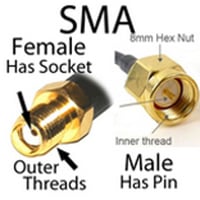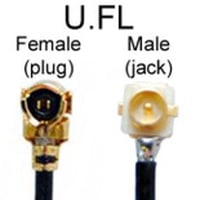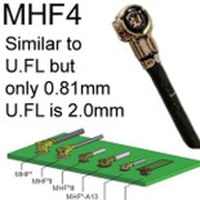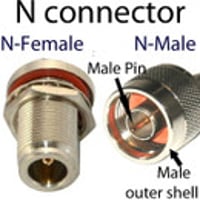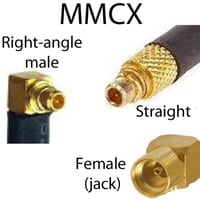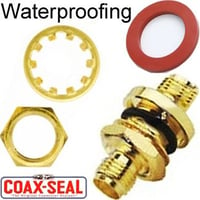FAKRA Cables & Adapters
SMA and RP-SMA cables to FAKRA connectors
FAKRA connectors are widely used in the automotive industry, globally
Key Features of FAKRA Cables:
- Standardized Color Coding: FAKRA connectors and cables come with a unique color-coding system that facilitates easy identification and prevents mismatches during installation.
- Durability: Built to withstand rough conditions, FAKRA cables can operate under extreme temperatures, typically ranging from -40°C to 105°C.
- Scalability: Designed for high-frequency applications, they provide consistent performance up to 6 GHz, making them suitable for a range of wireless technologies.
- Versatility: FAKRA connectors are built to support both single and double configurations, enhancing their utility across various devices.
- Secure Locking Mechanism: FAKRA cables come with a primary and secondary locking system, ensuring stable and reliable connections.
- Able to conduct a range of RF frequencies up to 6.0 GHz
- Most FAKRA connectors have a 50 ohm impedance but 60 and 75 ohm connectors are also available.
- 14 different designs that are individually color-coded for precision matching.
- Pre-assembly locking features that assist in the correct alignment and of the coaxial cable components.
- Housing that is resistant to shocks and vibration.
- Facilitation of the central coaxial cable and insert to rotate through 360 degrees which prevents cables becoming twisted or damaged while in use.
- Secure mating up to 100 mating cycles.
- FAKRA connectors are a distinctive type of SMB-derived connector for coaxial cables.
- Similarities with the Sub-Miniature Version B (SMB) connector include a center pin on the male connector and complementary basket on the female connector. Unlike the SMB connector, the FAKRA connector is housed in plastic and makes a tactile and audible clicking noise when correctly connected and locked in place.
These and other features mean that the FAKRA connector is able to meet the mechanical and environmental demands of the automotive industry and FAKRA connectors additional meet the requirements of the US Council for Automotive Research (USCAR).
Material Composition
The core of FAKRA cables primarily consists of a metal, typically copper or a copper alloy, which guarantees excellent conductivity. Surrounding the core is a layer of dielectric material, usually polyethylene or a similar insulating substance. The outer layer, designed for protection and durability, is made of a combination of metal and plastic materials.
Compatible Wireless Technologies
FAKRA cables are versatile and compatible with an array of wireless technologies, including but not limited to:
- Zigbee: A key player in smart home solutions, Zigbee's short-range communication benefits from FAKRA's reliable connectivity.
- Bluetooth: FAKRA's consistent performance at high frequencies makes it a go-to for Bluetooth applications.
- Wi-Fi: With the rise of IoT and the need for robust Wi-Fi connections, FAKRA cables can be a game-changer.
Applications of FAKRA Cables
- Automotive: From GPS systems to in-vehicle entertainment, FAKRA cables are integral to modern vehicles.
Given the specificity of its design it is unsurprising that the FAKRA connector has a wide range of applications in the automotive sector. FAKRA connectors are also commonly found in marine applications and motorcycles.
Cars carry multiple coax lines and the FAKRA connector meets the technology demands of contemporary vehicle design including the dedicated short range communications of automotive applications such as keyless entry and parking and positional sensors. FAKRA connectors also feature on car antenna, cellular phones, GPS and satellite radio.
- IoT Devices: Given their durability and reliability, they are increasingly being used in IoT devices that require stable wireless connections.
- Telecommunication: FAKRA connectors have found a place in various telecommunication gear, enhancing signal reliability.
Suitability for IoT Applications
Given IoT's emphasis on real-time data transfer and consistent connectivity, FAKRA cables stand out for their:
- Consistency: Their ability to perform consistently at high frequencies makes them suitable for devices that need uninterrupted data flow.
- Durability: IoT devices often operate in varying conditions. FAKRA cables, known for their ruggedness, can keep these devices connected irrespective of environmental challenges.
- Scalability: As IoT applications expand, FAKRA's scalability ensures they remain a viable choice for emerging technologies.
Types of FAKRA Cables
FAKRA connectors are categorized based on their specific functions and applications, leading to a variety of types, including:
- Universal Cables: Suitable for general applications, they come with a neutral color coding.
- GPS Cables: Tailored specifically for GPS technologies and applications.
- GSM Cables: Optimized for global system for mobile communication functionalities.
- Radio Cables: Designed for radio frequency applications.
Conclusions
For industries leaning heavily on IoT and automotive advancements, FAKRA connectors and cables seem to be the bridge leading to a more connected and efficient future.
The dynamic technological landscape has pushed the boundaries of wireless communication, resulting in more stringent requirements for connectors and cables. A remarkable entrant in this domain is FAKRA (Fachkreis Automobil), a German acronym that translates to "expert group for automotive." These cables have made a significant impact in the domain of wireless technologies, particularly in automobile and IoT applications.

